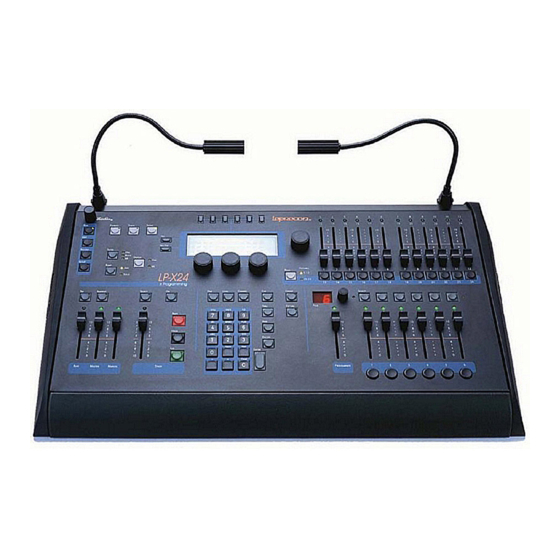
Table of Contents
Advertisement
Advertisement
Table of Contents

Summarization of Contents
Introduction to LP-X Series Consoles
LP-X Series Console Features Overview
Details the capabilities and specifications of the LP-X series consoles.
LP-X Console Board Layout
Describes the console's physical sections and their functions.
Power Up and Down Procedures
Step-by-step instructions for safely powering the console on and off.
Chapter One: Quick Start Guide
Console Orientation and Key Concepts
Introduces basic operation and fundamental concepts of the LP-X.
Manual Scene Faders Operation
Explains the use of faders for dimmer level control.
The Programmer Functionality
Details the role of the programmer in recording looks.
Moving Light Select Buttons
Describes how to select moving lights using ML Select buttons.
Dowse and No Dowse Modes
Explains how to control light states during programming.
Understanding Playbacks Stack Deep
Explains the functionality of playbacks for sequencing looks.
Practical How-To Guides
Provides step-by-step instructions for common tasks.
Chapter Two: Setup Essentials
The Instrument Menu for Fixture Management
Accessing functions for managing lighting instruments.
DMX Line Assignment Configuration
Setting up DMX addresses for connected lighting fixtures.
LP-X Instrument Library Management
Managing fixture data within the console's library.
Dimmer Patch Configuration
Mapping dimmers to board channels for control.
Control Features Usage
Using specific commands to control fixture attributes.
Show Maintenance Procedures
Performing show data backup, restore, and creation.
The Erase Menu for Data Management
Options for deleting various types of show data.
Chapter Three: Conventional Light Programming
Master Fader for Overall Output Control
Controls the total output level of the console.
Manual Scene Fader Operation
Primary interface for controlling conventional light intensity.
Bank Button for Fader Selection
Switches between different sets of manual scene faders.
Playback Functionality
Storing and sequencing lighting looks using playbacks.
Recording and Playing Back Looks
Core workflow for creating and recalling lighting looks.
Modifying Conventional Light Looks
Techniques for editing recorded lighting looks.
Overriding Looks at Run Time
Making temporary adjustments during live playback.
Chapter Four: Moving Light Programming
Moving Light Definitions and Properties
Explains fundamental concepts of moving light control.
No Change Attribute Setting
Feature to maintain attribute values from the previous look.
The Moving Light Library
Details the console's built-in database of moving light fixtures.
Getting Started with Moving Lights
Initial setup steps for integrating moving lights.
Recording Moving Light Looks
Process for creating lighting looks for moving fixtures.
Playing Back Moving Light Looks
Replaying recorded looks for moving lights.
Modifying Moving Light Looks
Techniques for editing recorded moving light looks.
Overriding Moving Light Looks at Run Time
Making temporary runtime adjustments to moving light looks.
Chapter Five: Advanced Programming and Editing
Clearing Playbacks
Procedures for removing looks from playbacks.
Copying Looks and Playbacks
Methods for duplicating looks and entire playbacks.
Automating Show Sequences
Setting up timed execution of lighting sequences.
Unlooping and Relooping Scene Lists
Controlling the playback behavior of scene lists.
Moving and Deleting Looks in Scene Lists
Editing the order and content of scene lists.
Programming Virtual Channels
Utilizing software-only channels for extended control.
Chapter Six: Creating Moving Light Labels
Creating Custom Labels
Overview of the process for creating new labels.
Creating Color or Beam Labels
Procedure for making labels for color and beam properties.
Creating Focus Labels
Procedure for making labels specific to the focus property.
Copying and Editing Labels
Methods for duplicating and modifying existing labels.
Deleting Labels
Process for removing labels from the system.
Chapter Seven: Working with Moving Light Attributes
Overriding Label Behavior
Modifying how labels affect fixture attributes.
Resetting Moving Light Attributes
Restoring attributes to their default values.
Working with Attributes in Edit Mode
Editing attributes during playback or editing sessions.
Chapter Nine: Chases
Creating Chases from Scene Lists
Converting scene lists into repeatable chase patterns.
Setting Chase Loop Counts
Configuring the number of times a chase repeats.
Converting Chases Back to Scene Lists
Reverting a chase back to its original scene list format.
Managing Chases at Run Time
Controlling chase execution during live playback.
Dark Move Chases
Creating chases that change attributes with intensity off.
Chapter Ten: Stacks
Recording Looks to the Stack
Process for adding looks to a stack sequence.
Playing Back the Stack
Executing sequences stored in the stack.
Editing Stack Contents
Modifying individual steps within a stack.
Automating Stack Execution
Setting up timed execution for stack steps.
Chapter Eleven: Moving Light Effects
Creating Label Effects
Overview of effects based on label sequences.
Creating Wheel-Order Chases
Creating chases based on fixture's wheel order.
Creating Label Chases (Non-Wheel-Order)
Creating chases with user-defined label order.
Creating Iris Flick Effects
Generating effects using the fixture's iris.
Creating Focus Effects
Generating shape-based effects for fixture focus.
Sequencing Lights within Effects
Controlling the order of light execution in effects.
Editing and Removing Effects
Modifying effects and removing lights from them.
Overriding Attributes in Effects
Modifying attributes while an effect is active.
Chapter Twelve: Other Setup Features
Locking and Unlocking the Console
Securing the console to prevent unauthorized changes.
The Group Menu for Fixture Organization
Grouping fixtures for streamlined programming.
Managing Default Settings
Modifying default values for system functions.
The DMX Menu for Channel Management
Reserving and un-reserving DMX channels.
The Update Menu for Software and Library
Updating the console's program and fixture library.
The Miscellaneous Menu for System Settings
Accessing MIDI, clock, and memory settings.
Creating and Editing Moving Light Devices
Adding and modifying custom fixture profiles.
Appendix A: Maintenance and Repair
Handling and Environmental Precautions
Guidelines for physical care and temperature exposure.
Power Requirements: 110/220 Volt
Information on selecting the correct voltage.
Warranty Information and Service
Details on product warranty and how to obtain service.
Appendix B: MIDI Protocol Specification
MIDI Message Formats and Controller Channels
Structure and details of MIDI messages used by the console.
MIDI Message Input and Output Behavior
How the LP-X sends and receives MIDI data.

Need help?
Do you have a question about the LP-X48 and is the answer not in the manual?
Questions and answers